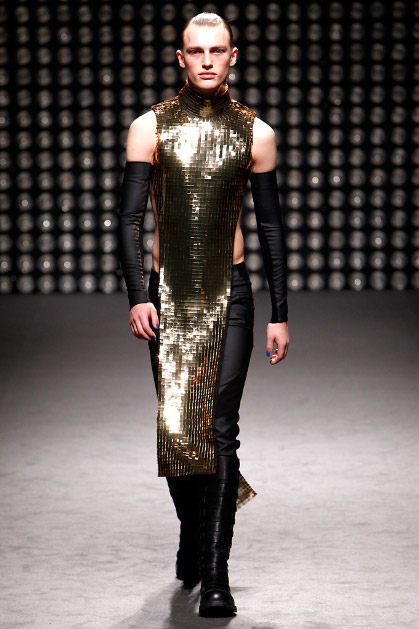





































Unlike his fashion showman peers, Gareth Pugh never gives his collections a title or clarifies a theme for them. He sees his work as a single seamless flow of ideas that expands or contracts to his bidding.
www.garethpugh.netParisFashion WeekFashion Brand
Unlike his fashion showman peers, Gareth Pugh never gives his collections a title or clarifies a theme for them. He sees his work as a single seamless flow of ideas that expands or contracts to his bidding.
Unlike his fashion showman peers, Gareth Pugh never gives his collections a title or clarifies a theme for them. He sees his work as a single seamless flow of ideas that expands or contracts to his bidding. His Fall collection might have been a contraction—or at least a consolidation. After several seasons of experimenting with film in collaboration with the budding genius Ruth Hogben, it was time again for Pugh to remind his audience of the physicality of what he does. In other words, it was showtime.
Pugh's support team is so attuned to him, you feel they could do this in their sleep—Matthew Stone contributed the gut-rumbling electronic soundtrack, Simon Costin created the futuristic-yet-primal backdrop, Alex Box did the mutant makeup ("spectral light" was her guideline). And Pugh provided the clothes: the tabard shapes, the strictly defined jackets cut on the square that fell away into points, the broad-shouldered pieces in bonded or articulated leather—all of them in Stygian black. This language is his and his alone, which is striking in one so young (he'll be 30 in August). It is also so defined that it is sometimes difficult to see how Pugh can grow it. Fall confirmed clues. Fluidity has become his friend. So has color. A black sheath with a cobalt blue cape attached was one of the show's strongest pieces. And Pugh may even have relaxed enough that he can now accommodate humor. The menswear in this show featured young models with torso-limning tops that erupted into chiffon pants with the flowing volumes of a floor-length skirt, or a parish priest's robes. It was, in fact, boyhood memories of the latter that inspired Pugh. The same wry religiosity probably accounted for the cross composed of intersecting zippers on the flaring, leather-sleeve dress that opened the show. That kind of detail suggested Pugh toying with his status as Crown Prince of the Fashion Goths.
He then dispelled the gothic gloom with a finale that armored his models in gold. Karlie Kloss was a fallen angel in her capelet, dress, and leggings. Why Pugh's men looked priestly when his women looked pagan might be the stuff of a thesis—or a film treatment, if Ruth Hogben doesn't already have enough on her plate.